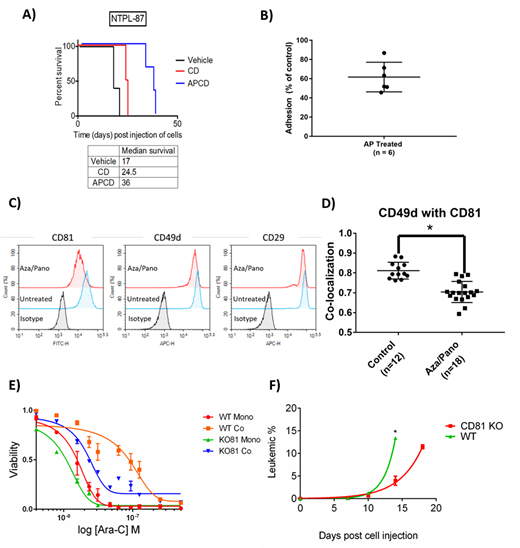Abstract
We previously demonstrated that a combination of epigenetic drugs azacitidine (DNA hypomethylating agent) and panobinostat (HDACi) can sensitize acute lymphoblastic leukemia (ALL) cell lines and a variety of patient-derived xenograft (PDX) lines to chemotherapy under conditions that mimic bone marrow microenvironment-induced chemoprotection (Quagliano et al., 2017, Leuk Res). Using disseminated PDX models, we observed that mice pre-treated with azacitidine and panobinostat combination (aza/pano) prior to receiving chemotherapy survived longer than mice treated with chemotherapy alone, indicating that epigenetic drugs chemo-sensitized ALL to chemotherapy in vivo (Fig. 1A). However, the mechanism by which this sensitization occurs was unknown.
Direct cell-cell contact was required for the chemoprotection of ALL cells in co-culture with osteoblast-like cells (Saos-2). Furthermore, adhesion of various ALL PDX lines to Saos-2 monolayers was reduced significantly (Fig. 1B) following treatment with aza/pano, indicating that aza/pano induced chemosensitization may be mediated by modulation of cell surface molecules. Therefore, we performed a high throughput flow cytometry assay using the BD LyoplateTM to investigate alterations in the expression of cell surface molecules following aza/pano treatment. This assay identified tetraspanin (TSPAN) protein CD81 as one of the candidate molecules downregulated on the cell surface by aza/pano. Aza/pano treatment also reduced surface expression of CD49d (integrin α4) and CD29 (integrin β1), which together form the VLA-4 receptor (Figure 1C). TSPANs like CD81 have previously been shown to interact with VLA-4; and regulate VLA-4 adhesion to VCAM-1 on bone marrow cells. To determine if the interaction between CD81 and VLA-4 was perturbed by aza/pano, surface co-localization of CD81 and CD49d was analyzed in immunofluorescence images using Volocity image analysis software. Following treatment with aza/pano, CD49d showed a significant reduction of co-localization with CD81 (Fig. 1D), suggesting aza/pano can disturb CD81/VLA-4 interaction. Previous differential gene expression analyses showed that CD81 transcript levels were higher in ALL in comparison to healthy bone marrow samples. Consistent with transcript data, we observed a significant increase in cell surface expression of CD81 in B-ALL PDX lines compared to immortalized B-cells by flow cytometry. Taken together, these data imply that aza/pano induced chemo-sensitization may be mediated through CD81.
To determine the specific role of CD81, we generated Nalm6 cells with homozygous CD81 knockout (KO) by CRISPR/Cas9 mutagenesis. CD81 KO was confirmed by Sanger sequencing and flow cytometry. CD81 KO cells had 60% reduction in their drug resistance index compared to wild-type cells (Fig. 1E), validating the role of CD81 in inducing chemo-resistance. Because of the role of CD81 in the regulation of cell adhesion by modulation of integrins, we evaluated the significance of CD81 in leukemia engraftment and progression. CD81 KO and WT cells were transplanted into NSG-SGM3 mice via tail-vein injection. Flow cytometry on flushed bone marrows after 96 h post cell injection revealed a reduced presence of CD81 KO cells, indicating that CD81 plays a role in ALL homing and engraftment in the bone marrow. Periodic analysis of peripheral blood in a long-term engraftment assay revealed a significant increase in leukemic percentage in mice transplanted with CD81 WT cells at 14 days post injection (Fig. 1F). These observations suggest that CD81 mediates chemoprotection by enhanced adhesion.
Conclusion
This study provides evidence for the possible role of CD81 in inducing chemoprotection by promoting adhesion between ALL cells and cells within the bone marrow microenvironment. Due to aza/pano's modulation of CD81 surface expression, it is possible that aza/pano induced chemo-sensitization is mediated by down regulation of CD81.
Kolb:Roche- Genentech: Membership on an entity's Board of Directors or advisory committees; Servier: Membership on an entity's Board of Directors or advisory committees.
Author notes
Asterisk with author names denotes non-ASH members.


This feature is available to Subscribers Only
Sign In or Create an Account Close Modal